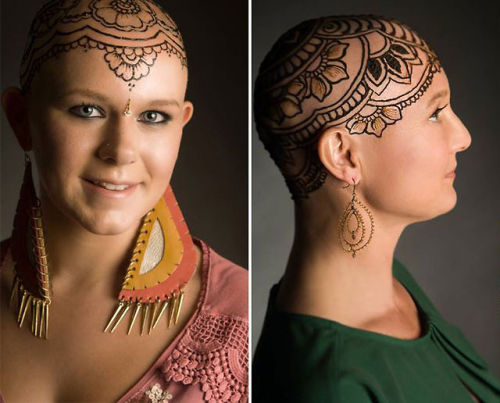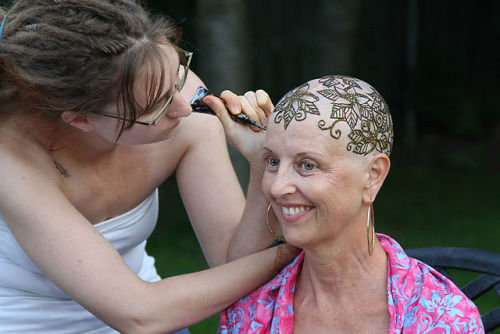fandomsandfeminism:consultingsuperhusbands:artmesohard:Many cancer patients can be overwhelmed with
fandomsandfeminism:consultingsuperhusbands:artmesohard:Many cancer patients can be overwhelmed with the physical and emotional difficulties of their disease, and the loss of their hair from chemotherapy treatment certainly doesn’t help. Henna Heals, a rich community of nearly 150 henna tattoo artists worldwide established by a team of 5 women in Canada, helps women with cancer feel confident and beautiful again by drawing elegant henna crowns on their bare heads:The intricate patterns that the artists create with all-natural henna paste are a unique and empowering substitute to the hats and wigs that many women use to cover their heads after losing their hair to chemotherapy. “For cancer patients, the henna crowns really are a healing experience,” claims Frances Darwin, the founder of Henna Heals. “This is all about them reclaiming a part of themselves that would normally be perceived as ill or damaged or not nice to look at and making it more feminine and beautiful.”The traditional South-Asian temporary tattoos, which are made with 100% natural home-made henna paste, last for around two weeks and have no harmful side-effects. Henna Heals also offers henna services for special events and does belly painting for mother-to-be, but they always donate 10% of their proceeds to compensate the cost of the henna crowns they make for cancer patients.I could yell ‘cultural appropriation’ right now but I don’t wanna because, fuck yeah, this is a great idea. And I’m gonna tell you why. In India, where I come from, in the Hindu community, henna is associated purely with religious or matrimonial ceremonies. During religious festivals, women wear it as a sign of not just celebration, but purity. Again, during weddings, the bride wears henna up to her elbows and up to her ankles, and, traditionally, there is a ‘mehendi (our word for henna that is applied on the skin) ceremony’ where the women dance and sing bawdy wedding songs and bless the new bride with fertility. The darkness of the mehendi is supposed to predict how deep the bond with the new husband will be, because, traditionally, marriages are arranged, so its a bit of a gamble, and women are forced to read signs into every little thing. A practice that is supposed to be for decoration then becomes a way to grade the new bride’s purity, chastity and the future happiness of her marriage. The same association with chastity and purity applies during religious ceremonies.Whenever I apply mehendi at a someone’s wedding, I always feel a niggling of GUILT, and ANXIETY - for not being the ideal Hindu woman; for being neither chaste, or pure, or even remotely spiritual. And mehendi, despite its prettiness, is also associated with a certain rigid idea of womanhood, motherhood and femininity. I say BREAK THAT.That’s why this beautiful, beautiful idea is a great way to unhinge leaf-paste (because that’s what it is!) from all sorts of medieval ideas about how women should be womanly. If it helps set anyone free, helps anyone feel pretty and proud, I say go for it.Because that’s what this is - reclaiming an art practiced in a female space, democratizing it, opening it up, applying it on anyone and everyone, free of moral and value judgement. Bringing it back to the delight possibly felt by women in Asia millenia back when they giggled ‘Ooh, hey lemme draw a flower on you with that cute leaf-paste’. Reclaiming it for us, and for all our uses, in all our different lives. This makes me fiercely happy.This is really beautiful. -- source link
Tumblr Blog : artmesohard.tumblr.com






